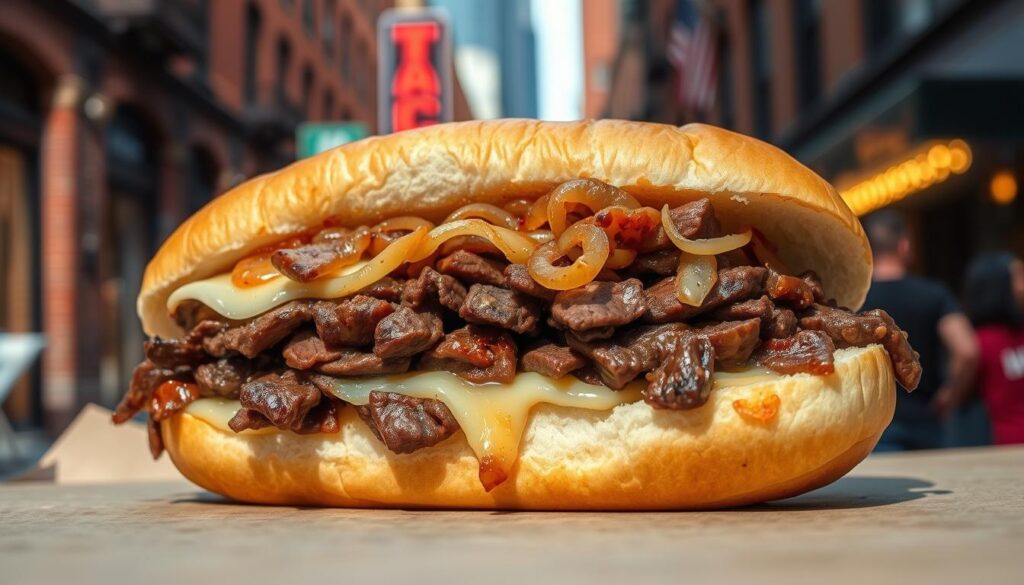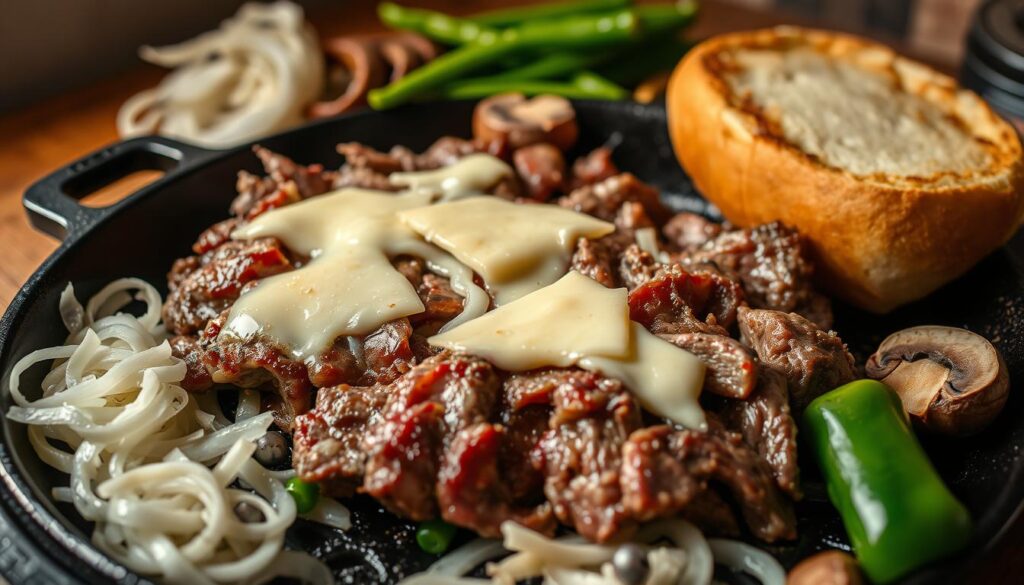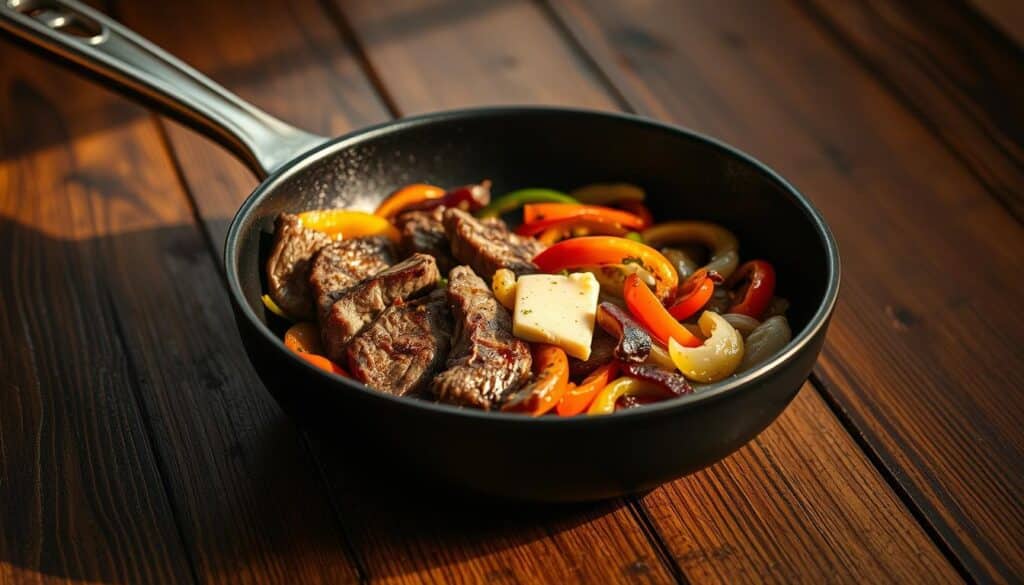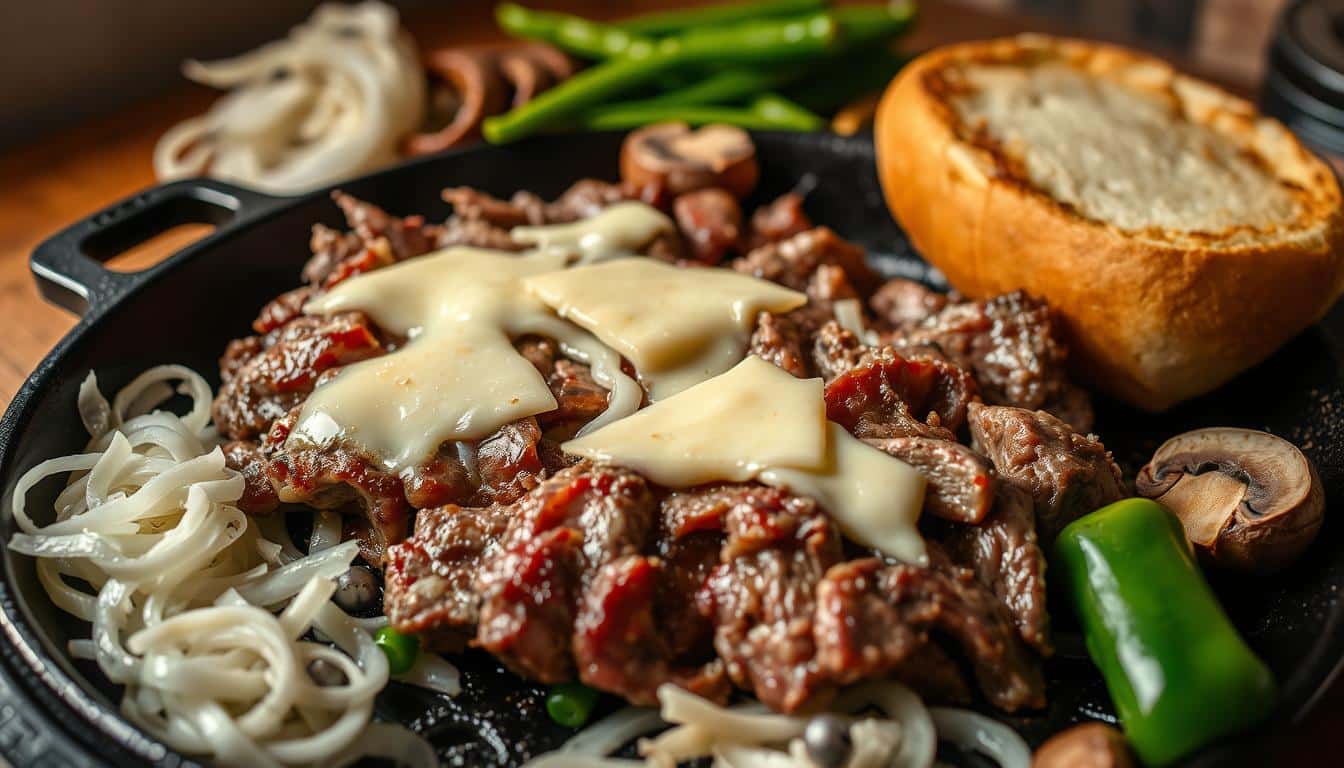There’s something magical about biting into a perfectly crafted sandwich. The combination of tender steak, melted cheese, and a soft hoagie roll creates a flavor explosion that’s hard to resist. For me, making this classic dish at home has become a cherished tradition, bringing friends and family together over a meal that’s both comforting and satisfying.
Thank you for reading this post, don't forget to subscribe!What makes a great cheesesteak? It’s all about the details. Thinly sliced steak, caramelized onions, and gooey provolone cheese are essential. The hoagie roll plays a crucial role too—soft yet sturdy enough to hold all the delicious fillings. Whether you’re a seasoned cook or a beginner, this recipe is designed to guide you step-by-step, ensuring success every time.

With just 15 minutes of prep and 25 minutes of cooking, you can create a meal that serves four. It’s affordable, too, costing around $15 for five large sandwiches. Ready to dive in? Let’s explore the history, tips, and techniques to make the best version of this iconic dish right in your kitchen.
Key Takeaways
- Learn how to make a classic cheesesteak with simple, affordable ingredients.
- Discover the importance of a quality hoagie roll for the perfect sandwich.
- Understand the cultural significance of this dish in American cuisine.
- Get tips on prep and cook times for a stress-free cooking experience.
- Explore variations to customize your cheesesteak to your taste.
Introduction: A Love for Philly Cheesesteaks
Few dishes evoke as much nostalgia and comfort as a well-made steak and cheese creation. For me, it’s more than just a meal—it’s a reminder of family gatherings, late-night cravings, and the joy of sharing good food. This iconic dish has a special place in my heart, and I’m excited to share why it’s a timeless favorite for so many.
What makes this sandwich so irresistible? It’s the perfect blend of flavors and textures. Tender beef, melted cheese, and caramelized onions come together in a way that’s both simple and extraordinary. Over the years, I’ve experimented with different recipes, but the classics always win. The secret lies in the details—quality ingredients and the right techniques.
One of the most important steps is using the right oil to sauté the ingredients. It ensures the beef stays juicy and the onions caramelize beautifully. Whether you’re sticking to tradition or adding a modern twist, the foundation remains the same: a hearty, flavorful dish that brings people together.
Join me as I explore what makes this dish so special. From its humble beginnings to its status as a cultural icon, there’s so much to love about this classic. Let’s dive into the world of authentic recipes and discover how to create a meal that’s as memorable as it is delicious.
Essential Ingredients & Tools for an Authentic Cheesesteak
Crafting an authentic dish starts with the right ingredients and tools. The foundation of a great meal lies in quality components and reliable equipment. Let’s break down what you’ll need to create a flavorful and satisfying experience.
Staple Ingredients
The heart of this dish is thinly sliced steak. It ensures tenderness and even cooking. Pair it with high-quality cheese, like provolone or American, for that gooey, melty texture. Fresh vegetables, such as onions and bell peppers, add depth and sweetness.
Don’t forget the hoagie roll. It’s not just a vessel—it’s a crucial part of the experience. A soft yet sturdy roll holds everything together without falling apart.
Must-Have Cooking Tools
A reliable skillet is essential for even heat distribution. It helps caramelize onions and sear the steak to perfection. A sharp knife is another must-have for achieving those paper-thin slices of beef.
Time management is key. A minute-by-minute approach ensures precision. For example, caramelizing onions takes about 10 minutes, while searing the steak requires just 2-4 minutes.
If you’re looking for another quick, one-pan meal, try this Boursin Chicken, Mushroom, and Asparagus Skillet. It’s versatile and perfect for busy weeknights.
Philly Cheesesteak Sandwiches: Choosing Steak, Cheese, and Rolls
The secret to a standout sandwich lies in the quality of its core ingredients. From the meat to the cheese and the bread, every choice matters. Let’s dive into how to select the best components for an unforgettable meal.
Steak: Ribeye vs. Top Round
When it comes to the meat, ribeye is my go-to choice. Its marbling ensures tenderness and rich flavor. Top round is a leaner alternative, but it requires careful cooking to avoid toughness. Thinly sliced cuts are essential for even cooking and that perfect texture.
Cheese: Provolone or Cheez Whiz?
The cheese debate is real. Provolone offers a creamy, mild flavor that complements the meat beautifully. Cheez Whiz, on the other hand, brings a nostalgic, gooey texture. Both are excellent choices—it’s all about personal preference.

Selecting the Perfect Roll
A sturdy yet soft hoagie roll is crucial. Amoroso rolls are the gold standard, but if they’re unavailable, look for a roll that can hold up to the juicy fillings without falling apart. The right bread makes all the difference.
Heat Management and Seasoning
Proper heat is key to caramelizing onions and searing the meat just right. Season generously with black pepper to enhance the flavors. A well-seasoned dish is always a winner.
Optional Additions: Mushrooms
For an extra layer of flavor, I love adding sautéed mushrooms. They bring an earthy richness that pairs beautifully with the other ingredients. It’s a simple way to customize your sandwich.
| Ingredient | Best Choice | Alternative |
|---|---|---|
| Steak | Ribeye | Top Round |
| Cheese | Provolone | Cheez Whiz |
| Roll | Amoroso | Sturdy Hoagie |
Prepping the Steak: Freezing, Slicing, and Seasoning
Preparing the perfect steak starts with mastering the basics: freezing, slicing, and seasoning. These steps ensure the meat is tender, easy to handle, and packed with flavor. Let’s break down each process to help you achieve the best results.
Tips for Thinly Sliced Steak
Thinly sliced steak is essential for even cooking and a tender bite. To make slicing easier, I recommend freezing the steak for about 30 minutes. This firms up the meat, allowing you to achieve paper-thin cuts with a sharp knife.
When slicing, angle the knife slightly and cut against the grain. This technique ensures the steak remains tender and doesn’t become chewy. Consistent slices also cook evenly, giving you a perfect texture every time.
Seasoning Secrets
Seasoning is where the magic happens. A simple mix of salt, black pepper, and garlic powder enhances the natural flavor of the steak. I also like to add a pinch of smoked paprika for a subtle depth of taste.
For the best results, season the steak just before cooking. This prevents the salt from drawing out moisture, keeping the meat juicy. If you’re using provolone, let it melt over the steak for a creamy finish that ties everything together.
Quality ingredients make a difference. Opt for top-grade steak and fresh seasonings to elevate the dish. With these tips, you’ll master the art of prepping steak like a pro.
Sautéing Vegetables to Perfection
Sautéing vegetables is an art that transforms simple ingredients into a flavorful masterpiece. When done right, it enhances their natural sweetness and texture, making them the perfect side to any meal. Let’s dive into the techniques for caramelizing onions and sautéing bell peppers to elevate your dish.
Caramelizing Onions
Caramelizing onions is all about patience and high heat. Start by slicing the onions thinly and heating a skillet with a bit of oil. Cook them over medium-high heat, stirring occasionally, until they turn golden brown. This process releases their natural sugars, creating a rich, sweet flavor.
For the best results, avoid overcrowding the pan. This ensures even cooking and prevents steaming. A well-caramelized onion adds depth to your dish, making it a standout mixture of flavors.
Sautéing Bell Peppers
Bell peppers bring a vibrant color and crunch to your meal. Slice them into thin strips and sauté them in a hot skillet with a touch of oil. Cook them until they’re tender but still retain a slight bite. This method preserves their nutrition while enhancing their natural sweetness.
Pairing caramelized onions and sautéed peppers creates a balanced mixture that complements the main dish. These vegetables not only add flavor but also boost the meal’s nutritional value.
Why Sautéing Matters
Sautéing vegetables at the right temperature (350°F to 450°F) ensures they retain up to 80% of their nutrients. This method also reduces their volume by about 50%, concentrating their flavors. Using a non-stick pan can cut down on oil, making it a healthier option.
These sautéed vegetables are more than just a side—they’re a flavorful addition that enhances the overall dish. With proper timing and temperature control, you can create a meal that’s both delicious and nutritious.
| Vegetable | Cooking Time | Key Benefit |
|---|---|---|
| Onions | 10-12 minutes | Rich, sweet flavor |
| Bell Peppers | 5-7 minutes | Retains crunch and nutrients |
Merging Steak, Veggies, and Cheese: The Skillet Method
Bringing together steak, veggies, and cheese in one skillet creates a dish that’s both hearty and flavorful. This method ensures every bite is packed with savory goodness. The key is layering the ingredients carefully and managing the heat to keep everything warm and cohesive throughout the day.
Layering the Ingredients
Start by placing the thinly sliced ribeye in the skillet. Cook it over medium-high heat until it’s just browned. Next, add the caramelized onions and sautéed bell peppers. These veggies add sweetness and depth to the dish.
For an extra layer of flavor, I like to include mushrooms. They bring an earthy richness that complements the other ingredients. Use a sharp knife to slice them evenly for consistent cooking.

Cheese Melting Techniques
Once the steak and veggies are cooked, it’s time to add the cheese. I prefer using a mix of provolone and Cheez Whiz. Provolone offers a creamy texture, while Cheez Whiz adds a nostalgic, gooey finish.
To melt the cheese evenly, cover the skillet for a minute or two. This allows the heat to work its magic. If you’re serving later, keep the skillet on low heat to maintain the perfect consistency.
| Ingredient | Role |
|---|---|
| Ribeye | Provides tender, flavorful meat |
| Bell Peppers | Adds sweetness and crunch |
| Cheese | Creates a creamy, melty texture |
For more skillet-inspired recipes, check out this one-pan skillet dish. It’s a versatile option that’s perfect for any day of the week.
Assembling Your Perfect Cheesesteak Sandwich
The final step in creating a mouthwatering dish is all about assembly. This is where all your hard work comes together, and every detail matters. From toasting the roll to layering the ingredients, each step ensures a flavorful and satisfying experience.
Toasting the Hoagie Roll
Start by toasting the hoagie roll to golden perfection. Warm a bit of butter in a skillet medium heat and place the roll cut-side down. This step adds a crispy texture and prevents the roll from becoming soggy. Toasting also enhances the flavor, making it the perfect base for your dish.
Final Assembly Tips
Once the roll is toasted, it’s time to layer the ingredients. Start with the thinly sliced steak, followed by caramelized onions and sautéed bell peppers. Add the melted cheese last, ensuring it coats the other ingredients evenly. This creates a rich sauce that ties everything together.
To avoid excessive fat, use a paper towel to blot the steak before assembling. This keeps the dish flavorful without being greasy. For the best results, serve immediately while everything is warm and the cheese is gooey.
| Step | Key Detail |
|---|---|
| Toast Roll | Use warmed butter for crispiness |
| Layer Ingredients | Steak first, then veggies, and cheese last |
| Serve Immediately | Keeps flavors and textures intact |
With these tips, you’ll create a dish that’s as visually appealing as it is delicious. Whether you’re cooking for one or a crowd, this method ensures a perfect serving every time.
Creative Twists and Personal Touches
Experimenting with flavors can turn a classic dish into something uniquely yours. Whether you’re looking to save money or add a personal flair, there are countless ways to customize this recipe. Let’s explore some creative twists that make it your own.
Budget-Friendly Additions
If you’re watching your wallet, there are plenty of affordable ingredients that still pack a punch. Swap out ribeye for a leaner cut like top round or sirloin. These options are easier on the budget while still delivering great flavor.
Adding extra vegetables like mushrooms or zucchini is another way to stretch your ingredients. They’re inexpensive and add a boost of nutrition. For a quick cooking hack, use a non-stick pan to reduce the need for extra oil.
Alternative Cheese & Topping Options
Cheese is where you can really get creative. While provolone and Cheez Whiz are classics, try experimenting with Swiss, cheddar, or even a sprinkle of feta. Each cheese brings its own unique flavor to the dish.
For toppings, think outside the box. Pickled jalapeños add a spicy kick, while roasted garlic brings a rich, savory note. These small changes can make a big difference in the final result.
When it comes to cooking, don’t be afraid to use what you have on hand. A cast-iron pan or even a griddle can work just as well as a traditional skillet. The key is to make the recipe work for you in your own way.
By adding your personal touch, you can make philly a dish that’s truly one-of-a-kind. Whether it’s a budget-friendly option or a bold new topping, the possibilities are endless.
Conclusion
Creating a memorable meal is all about the details, from the first slice to the final bite. Each step—whether it’s thinly cutting the steak, toasting the roll, or seasoning with pepper—plays a crucial role in achieving the perfect balance of flavors. Using a large skillet ensures even cooking and keeps the ingredients warm and cohesive.
This recipe is more than just a dish; it’s an experience. The combination of tender steak, caramelized onions, and melted cheese creates a harmony that’s hard to resist. I encourage you to try it at home and make it your own. Add your favorite toppings or experiment with different cheeses to suit your taste.
If you enjoyed this recipe, why not explore other hearty meals like this venison roast? It’s another great way to elevate your cooking skills. Share your results and let me know how you personalized this classic dish!
FAQ
What’s the best type of steak to use for an authentic flavor?
I always recommend using ribeye steak for its rich marbling and tenderness. Thinly sliced, it cooks quickly and absorbs flavors beautifully.
Can I use a different type of cheese besides provolone?
Absolutely! While provolone is classic, I’ve tried using American cheese or even Cheez Whiz for a creamier texture. It’s all about personal preference.
How do I slice the steak thinly without it falling apart?
I find freezing the steak for about 30 minutes first makes it easier to slice thinly with a sharp knife. It’s a game-changer!
What’s the secret to perfectly caramelized onions?
I cook them low and slow in a skillet with a bit of oil or butter. Patience is key—it takes about 15-20 minutes to get that sweet, golden-brown color.
Can I add other vegetables to my sandwich?
Of course! I love adding sautéed bell peppers or mushrooms for extra flavor and texture. It’s a great way to make it your own.
How do I prevent the hoagie roll from getting soggy?
I always toast the roll lightly before assembling. It adds a nice crunch and keeps it from absorbing too much moisture.
Can I make this recipe ahead of time?
While it’s best fresh, you can prep the steak and veggies ahead. Just reheat everything in a skillet before assembling for the best flavor.
What’s the best way to melt the cheese evenly?
I layer the cheese over the hot steak and veggies in the skillet, then cover it for a minute. The steam helps it melt perfectly.
Are there any budget-friendly alternatives to ribeye steak?
Yes! I’ve used sirloin or even flank steak when I’m on a budget. Just make sure to slice it thinly for tenderness.
Can I make this recipe vegetarian?
Definitely! I’ve tried using portobello mushrooms or plant-based steak substitutes. Add your favorite cheese and veggies for a delicious twist.
There are no reviews yet. Be the first one to write one.

